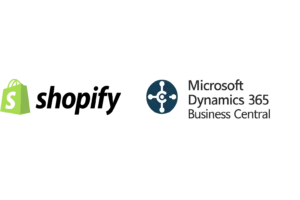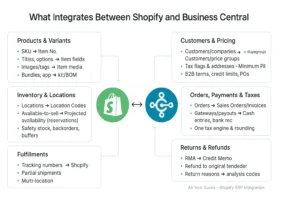
Connecting Shopify with Microsoft Business Central is beyond an IT integration; it is the way your storefront and back office functions on a common point of truth. With proper setups in place, orders are automatically posted, inventory is up to date, and the finance department finishes its closing quicker, and no longer has to rely on manual spreadsheets to update the customer.
This guide helps you understand what you can expect when taking a disciplined approach to roll out: which data synchronizes, what path you should select to integrate, how to introduce in controlled incremental stages, and what you can do to ensure that your solution remains reliable as you scale. You will understand when the native connector will work and when it should be replaced with custom development, and when orchestration and monitoring capabilities in an iPaaS are worth the additional cost.
If you’ve been burned by brittle bridges before, you’ll learn the guardrails that prevent déjà vu. Use this as your working checklist for Shopify ERP integration that sticks.
What Integrates Between Shopify and Business Central

You’re syncing the “truth” across both systems so they always show the same reality. At a high level, five things move in lockstep: products & variants, inventory & locations, customers & pricing, orders, payments & taxes, and fulfillments, returns & refunds.
Nail these mappings once, and everything downstream, picking, posting, payouts, and customer updates, stays clean without manual fixes.
-
Products & Variants
You’re aligning merchandising in Shopify with item records in BC, so product identity is consistent everywhere.
What to Map
- Map each Shopify SKU to a single Business Central Item No. Use one variant per SKU and keep SKUs unique across the entire catalog.
- Sync titles, options, and attributes from Shopify to the matching Item fields and variant dimensions in Business Central.
- Copy descriptions, images, and tags/collections to the appropriate Item details and media fields in Business Central.
- If you sell bundles or kits, pick one model: manage them in a Shopify bundle app or model them as a kit/BOM in Business Central. Don’t try to maintain both.
Common Mistakes
- Renaming SKUs during cutover breaks the SKU–Item link and can create duplicates. Freeze SKU changes until after go-live.
- Letting both systems edit the product master causes conflicts and data drift. Assign a single product master (Shopify or BC) and enforce it.
-
Inventory & Locations
You’re keeping “what’s available” aligned across warehouses, stores, and the site.
What to Map
- Map each Shopify location to a unique Business Central Location Code so stock movements are recorded consistently.
- Sync available-to-sell quantities with Business Central projected availability, factoring in reservations and allocations to avoid phantom stock.
- Set safety stock, backorder rules, and buffer quantities for each location to prevent overselling and protect service levels.
Pro Tips
- Push fast-movers near real time; batch slow-movers on a schedule.
- Run nightly reconciliation to catch drift early
-
Customers & Pricing
You’re matching shoppers and accounts to customers and price logic in BC.
What to Map
- Map Shopify customers and companies to the corresponding Business Central customer records and customer price groups.
- Synchronize tax flags, exemptions, and addresses, exposing only the minimum PII required in each system.
- For B2B accounts, carry over contract price lists, payment terms, purchase order numbers, and credit limits so sales orders apply the correct negotiated conditions automatically.
Guardrails
- Choose a single price authority, either Business Central or Shopify, and stick to it.
- Mirror only the fields that support, finance, and operations need; leave everything else where it belongs.
-
Orders, Payments & Taxes
You’re turning carts into auditable sales docs with the right accounting treatment.
What to Map
- Map Shopify orders to Business Central Sales Orders (or directly to Sales Invoices if your workflow requires it).
- Record payment-gateway transactions and payouts as cash entries in Business Central and reconcile them during bank reconciliation.
- Use a single tax engine, either Shopify or Business Central, and ensure identical rounding rules and jurisdiction settings to avoid discrepancies.
Implementation Risks
- If your workflow includes split shipments, configure Business Central to support partial picks and multiple fulfillments; otherwise, orders will stall or mispost.
- Map discounts, gift cards, and store-credit transactions to explicit GL accounts so postings remain auditable and the month-end close stays clean.
-
Fulfillments, Returns & Refunds
You’re closing the loop so customers see tracking and finance sees clean reversals.
What to Map
- After a shipment is posted in Business Central, push the carrier and tracking number back to the corresponding Shopify fulfillment so customers receive accurate updates.
- For returns, translate the RMA into a Credit Memo in Business Central and process the refund back to the original payment method to preserve a clean audit trail.
- Standardize return reasons and map each one to an analysis code in Business Central so you can report on trends and identify root causes.
Golden Rule
- If finance can’t audit it, don’t automate it yet. Add the missing field, then automate.
Choose Your Integration Approach
-
Native BC–Shopify Connector
Use the standard connector when you want speed to value and opinionated, proven mappings without heavy code.
When it fits
- You run a single Shopify store and one (or a small number of) Business Central companies.
- Your catalog uses standard variants and does not depend on complex bundles or kits.
- Your pricing and tax rules are straightforward and don’t require custom logic.
- Your team prefers configuration over custom development and long-term code maintenance.
What you gain
- You finish the build faster and carry less maintenance overhead.
- You inherit mappings that follow Microsoft and Shopify best practices, which reduces rework and surprises later.
-
Custom API Integration
Go custom when you need full control over data shapes, timing, and business rules.
When it fits
- You sell complex bundles or build-to-order products, or you require special fulfillment logic such as split manufacturing and drop-ship hybrids.
- You support heavy B2B flows, including quotes-to-orders, contract pricing, and hierarchical accounts with delegated purchasing.
- You operate multiple brands, multiple stores, or multiple Business Central companies that share catalogs but need distinct rules and presentation.
- You must orchestrate tightly with a WMS or 3PL and meet strict compliance or audit requirements.
What you gain
- You get exact behavior aligned to your processes, not approximations.
- You implement tailored error handling and observability that your team can trust.
- You establish future-proof integration patterns that extend cleanly to new channels and systems.
-
iPaaS / Middleware
Choose middleware when you orchestrate many systems and want monitoring, retries, and audit trails out of the box.
When it fits
- You’re coordinating Shopify, BC, WMS, CRM, marketplaces, 3PLs
- Your team prefers visual flows and admin over code
- You want alerting and dashboards on day one
Trade-offs
- You’ll incur a recurring subscription cost and be responsible for operating one additional integration hub.
- You can ship changes faster and monitor flows more easily, though you’ll also be tied to the middleware vendor’s roadmap and uptime.
Call it Shopify integration with ERP or unified commerce, the right choice is the one that keeps data correct with the least ops overhead.
How All Your Ducks Help
We at All Your Ducks turn an integration project into a clear plan, a durable build, and a calm handoff that your team can trust.
Here’s how we support you from kickoff to scale without the chaos.
What We Do
- We run a Success Criteria Workshop to lock masters, define success metrics, and finalize field mappings before any data moves.
- We build the integration with the native connector, custom APIs, or an iPaaS, whichever best fits your complexity, budget, and timeline.
- We manage UAT and cutover with golden test cases, a documented rollback plan, and hands-on hypercare, so go-live is boring (in the best way).
- We provide ongoing support with monitoring dashboards, nightly reconciliation jobs, audit assistance, and scale work as your volume and channels grow.
If you’re ready to replace “connect the systems” with “it just works,” we’ll map it, build it, and make it stick.
Bottom Line
Choose the integration pattern, native connector, custom API, or iPaaS, based on complexity and governance. Set single sources of truth for product, price, inventory, tax, and customer data; document mappings, and include only required fields. Validate with repeatable UAT and freeze SKUs before cutover. After go-live, enforce idempotent order posting, bounded retries, monitored dead-letter queues, and nightly reconciliation.
Use one tax engine and explicit GL paths for discounts, payouts, and refunds. Sync projected availability (including reservations) and maintain cycle counts. Assign owners for alerts, dashboards, and exception clearance. Executed this way, Shopify ERP integration is reliable and scalable; executed loosely, shopify integration with ERP invites rework and risk.
Book a 45-minute integration diagnostic with All Your Ducks.
Ready to move?
FAQs
1. What is ERP integration with Shopify?
It’s the real-time connection between your Shopify store and an ERP, so both share one source of truth. Products, inventory, customers, orders, taxes, shipments, returns, and refunds stay in sync. Manual entry drops. Stock accuracy and financial postings improve. In short, Shopify ERP integration replaces spreadsheets with controlled, auditable flows.
2. Which ERP systems integrate with Shopify?
Most leading ERPs do. Microsoft Dynamics 365 Business Central integrates via a native connector. Oracle NetSuite, SAP Business One and S/4HANA, Acumatica, Sage (Intacct, X3), and Infor CloudSuite connect through certified connectors, iPaaS platforms, or custom APIs. Depth varies by approach, so match the method to your catalog, B2B needs, and compliance requirements.
3. Do I need an ERP with Shopify?
Not always. If you have a small catalog, one location, simple pricing and tax, and basic accounting, Shopify alone can work. Add an ERP when complexity rises: multiple warehouses or companies, large SKU counts, B2B price lists and terms, MRP or purchase-to-pay, audit demands, or slow, error-prone closes. When stock accuracy, postings, or reporting start slipping, Shopify integration with ERP usually pays for itself.
4. How do I integrate Shopify with an ERP?
Pick an approach, native connector for speed, iPaaS for orchestration and monitoring, or custom APIs for full control. Define system-of-record rules for product, price, inventory, tax, and customer data. Map fields and GL paths. Build and test in a sandbox with “golden” SKUs and orders. Enforce idempotent order posting, bounded retries, and a dead-letter queue. Cut over with UAT passed twice, SKUs frozen, and nightly reconciliation for orders, inventory, and cash. Maintain dashboards and human-routed alerts. Done well, your shopify ERP integration is predictable, auditable, and scalable.

